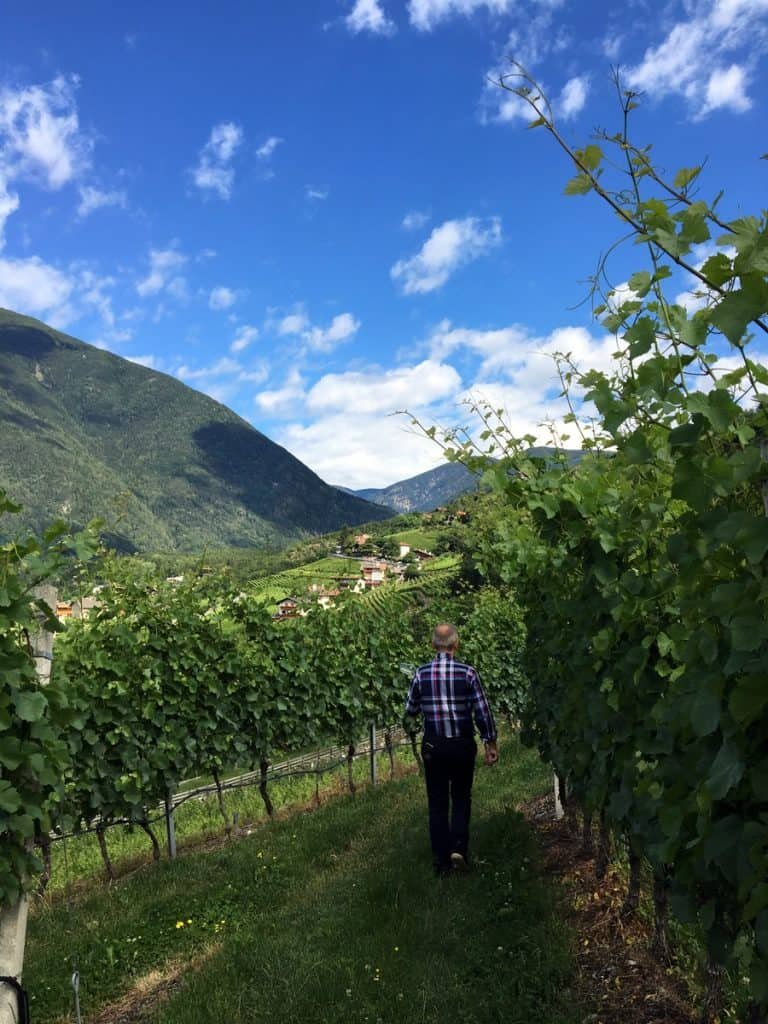
I am not one to spend my summer holidays just lying on a sunbed. I prefer to be active like a week improving my tennis or learning to waterski in a resort by the Mediterranean, doing a walking pilgrimage along the Camino or hiking up ski mountains to follow a gourmet ski hut trail. Many ski resorts now offer a variety of summer activities like these and it makes a great getaway, with clean mountain air, great food and usually a nice wellness hotel and spa nearby too.
A well-planned gourmet hiking trip can be a fantastic way to spend a few days in the summer. Europe offers a number of inspiring, well-maintained and diverse hiking trails that will take you to places with wonderful scenery and exceptional food. If you’re planning a long walk on the continent, then don’t miss the chance to indulge in the culinary delights on offer along the way. You will find a combination of great restaurants on the trail, ski hut food safaris and local food producers and vineyards to discover too.

You can spend your days tackling hills, forests or mountains, immersed in nature whilst building your appetite for memorable evening meals. But to get the best from your trip, you’ll need to prepare yourself. That might mean investing in good hiking gear like investing in a pair of women’s walking boots, a lightweight waterproof jacket and a day pack but actually planning your destinations might make the biggest difference of all.
So, which European trails are worth hiking for foodies?
South Tyrol Summer Ski Huts Gourmet Tour

The South Tyrol region in northern Italy offers one of Europe’s most distinctive culinary hiking experiences through its summer ski huts gourmet tour. This unique adventure transforms the area’s extensive network of mountain huts and alpine lodges into a progressive dining experience across the dramatic Dolomites landscape.
The season for a hut-to-hut tour in the Dolomites is from mid-June to mid-September when the mountain huts reopen after winter and offer their full culinary programs. These tours typically span 3-7 days depending on your chosen route and fitness level, with most itineraries covering between 50-120 kilometers of mountainous terrain.
The hiking is moderately challenging due to the alpine setting, with daily elevation gains ranging from 400-800 meters, making it suitable for hikers with good fitness levels and some mountain experience.
After you reach your hiking destination, don’t forget to reward yourself with local dishes at one of the many alpine inns and mountain huts. The culinary focus centres on hearty Tyrolean specialities including speck (cured ham), knödel (dumplings), apple strudel, and locally produced cheeses, all paired with stunning panoramic views of the surrounding peaks. Each hut offers its own specialities, from traditional Alpine fare to modern interpretations of regional cuisine.
The terrain varies from well-maintained mountain paths to more challenging rocky sections, requiring sturdy hiking boots and weather-appropriate gear. While the routes are well-marked and the huts provide comfortable overnight accommodation, the mountainous nature means this tour is best suited for hikers with moderate to good fitness levels rather than complete beginners.
You can do this hut-to-hut tour in a day, actually quite a long day. Just know that parts of it can be done by ebike too and there are guides that will accompany you all the way if you need.
The Alsace Wine Trail, France
Alsace is renowned worldwide for its exceptional vineyards and distinctive wine culture. This picturesque trail winds through some of France’s most celebrated wine regions, offering hikers the chance to sample world-class Rieslings, Gewürztraminers, and Pinot Noirs while enjoying traditional Alsatian cuisine.
The route takes you through charming half-timbered villages where you can taste regional delicacies like coq au vin, tarte flambée (flammekuechen), and choucroute garnie.
The trail features a mix of cobblestone village paths and dirt vineyard tracks, making sturdy hiking boots essential for comfort and stability. The terrain is generally gentle with rolling hills, making it accessible to hikers of varying fitness levels.
Many sections can be completed as day hikes, allowing you to return to comfortable village accommodations each evening. The route passes numerous family-owned wineries and caves (cellars) where you can learn about traditional winemaking methods while tasting the fruits of centuries-old expertise.
The Appian Way, Italy
Among the most historically significant routes of the early Roman Republic, the Via Appia originally linked Rome to Brindisi in southeastern Italy. Today, hiking sections of this ancient road offer an unparalleled combination of history and culinary excellence. The trail takes you through the heart of Italian food culture, where you’ll encounter handmade pasta in every imaginable form, artisanal olive oils, and traditional breads baked in centuries-old ovens.
The route showcases Italy’s incredible regional diversity, from the hearty Roman dishes of the north to the seafood-focused cuisine of the south. Along the way, you’ll discover family-run trattorias serving recipes passed down through generations, local markets brimming with fresh produce, and olive groves where you can witness traditional harvesting methods. The trail also features remarkable historical structures, including ancient Roman bridges, tombs, and mile markers that have stood for over two millennia.
The terrain varies from ancient stone paving to modern country roads, with generally moderate elevation changes. Most sections are suitable for hikers of all fitness levels, though the length of the complete route means most people tackle it in sections over multiple trips.
The Rota Vicentina, Portugal
This network of interconnected trails along Portugal’s rugged Atlantic coast offers some of Europe’s finest seafood experiences. Rather than a single continuous route, the Rota Vicentina comprises multiple pathways that can be combined according to your interests and time constraints. The trails take you through traditional fishing villages where the day’s catch is prepared using methods unchanged for generations.
The culinary highlights include perfectly grilled sardines, fresh seafood rice dishes, and the famous cataplana, a traditional seafood stew named after the distinctive clam-shaped copper pot in which it’s cooked. Local restaurants often feature catch-of-the-day menus that change based on what the fishing boats bring in that morning. The region is also known for its excellent wines, particularly the crisp Vinho Verde that pairs beautifully with the coastal cuisine.
The coastal paths offer stunning ocean views but can be challenging due to cliff-top sections and occasionally rough terrain. The inland routes through traditional villages are generally easier and suitable for most fitness levels. The best time to visit is late spring through early fall when the weather is most favorable and restaurants are fully operational.
Transylvania’s Village Trails, Romania

Contrary to popular vampire folklore, Transylvania during summer reveals itself as a pastoral paradise with some of Europe’s most authentic rural food experiences. The region’s village trails connect traditional communities that have maintained their culinary traditions for centuries, with a particular emphasis on bread-making and cheese production.
The trails wind through landscapes that seem frozen in time, where horse-drawn carts still work the fields and traditional methods of food preservation remain common. Local specialities include hearty soups, fresh cow’s and sheep’s milk cheeses, and bread baked in wood-fired ovens. Many villages offer homestay experiences where you can participate in traditional cooking methods and learn about time-honoured food preservation techniques.
The terrain is generally gentle with moderate hills, making these trails accessible to hikers of most fitness levels. The routes often follow ancient cart paths and pastoral tracks through meadows and forests. The rural setting means advance planning is essential, as services can be limited compared to more developed tourist areas.
The Gourmet Forest Experience, Black Forest, Germany

The Black Forest region of southwestern Germany offers a unique foraging and feasting experience that connects hikers directly with the forest’s natural bounty. The Baiersbronn area has become known as “culinary hiking heaven,” with restaurants featuring locally-foraged ingredients, hikes led by wild plant guides, and regional food specialities that include pine needle-infused ice cream. This immersive culinary adventure combines guided foraging walks with gourmet dining experiences that showcase the forest’s edible treasures.
The gourmet forest experience typically involves guided walks where expert foragers teach participants to identify and harvest wild mushrooms, berries, herbs, and other edible plants. The collected ingredients are then transformed into sophisticated dishes by skilled chefs who specialize in wild cuisine. Common foraged items include chanterelles, porcini mushrooms, wild garlic, elderflowers, and various medicinal herbs that have been used in traditional German cooking for centuries.
The terrain consists primarily of well-maintained forest paths with moderate elevation changes, making these experiences accessible to hikers of all fitness levels. The dense, dark forests create an atmospheric hiking environment that feels almost mythical, with trails winding through ancient woodlands and past traditional Black Forest farms. The region’s famous cuckoo clock villages provide charming bases for multi-day foraging adventures.
The experience is typically structured as day-long or weekend programs, combining 3 to 4 hours of guided foraging with cooking workshops and multi-course meals. Many programs operate from May through October when the forest’s bounty is at its peak, though different seasons offer unique foraging opportunities. You can book this experience through the local tourist office.
Lauterbrunnen Valley, Switzerland

The spectacular Lauterbrunnen Valley provides some of Switzerland’s most challenging and rewarding alpine hiking, with culinary experiences that perfectly complement the dramatic mountain scenery. The valley, carved by glaciers over millennia, offers hiking routes ranging from gentle valley-floor walks to demanding high-altitude trails.
The culinary focus centres on traditional Swiss mountain fare, most famously the various styles of fondue that provide the perfect calorie-dense fuel for alpine adventures. Local mountain restaurants and huts serve hearty dishes featuring locally produced cheeses, cured meats, and potato-based specialties like rösti. The region’s dairy tradition is exceptional, with many huts producing their own cheese from cows that graze the high alpine pastures.
The hiking ranges from easy valley walks suitable for families to challenging high-altitude routes requiring mountaineering experience. The more difficult trails reward hikers with stunning views of forest-covered peaks, glacial valleys, and some of the Alps’ most dramatic waterfalls.
Weather conditions can change rapidly in the mountains, so proper gear and experience are essential for the more challenging routes.
The Camino de Santiago French Way Gourmet Route
The French Way (Camino Francés) is the most famous and popular route of the Camino de Santiago pilgrimage, stretching 790 kms from St-Jean-Pied-de-Port in France to Santiago de Compostela in Spain. While traditionally a spiritual journey, the French Way has evolved into an exceptional culinary adventure that showcases the diverse regional cuisines of northern Spain, with particular emphasis on world-class vineyards and artisanal cheesemakers along the route.
The culinary journey begins in the Pyrenees with hearty Basque cuisine and evolves as you cross through distinct Spanish regions.
Wine lovers can explore incredible Camino Wine Routes along the way, particularly through the renowned Rioja region where the path passes directly through some of Spain’s most prestigious vineyards. Many wineries offer special pilgrim tastings and tours, allowing walkers to sample exceptional Tempranillo wines while learning about centuries-old winemaking traditions.
The route features numerous artisanal cheesemakers, particularly in the regions of Castilla y León and Galicia. Traditional products include Cabrales blue cheese from Asturias, Manchego-style cheeses from Castilla, and the famous Tetilla cheese as you approach Galicia. Many producers offer visits where pilgrims can witness traditional cheese-making processes and purchase supplies for the trail.
The French Way typically takes 4-6 weeks to complete, covering approximately 25-30 kms per day. The terrain varies from challenging mountain passes in the Pyrenees to gentle rolling hills through wine country, making it suitable for walkers of moderate fitness levels. The route is well-marked with yellow arrows and offers excellent infrastructure including pilgrim hostels (albergues), restaurants, and supply stops.
The path passes through historic cities like Pamplona, Burgos, and León, each offering distinct culinary specialties. Pamplona is famous for its pintxos (small plates) culture, Burgos for its morcilla (blood sausage) and lechazo (roast lamb), while León showcases cecina (cured beef) and local wines. As you approach Santiago, Galician cuisine takes center stage with fresh seafood, pulpo a la gallega (octopus), and the famous Albariño wines.
The social aspect of the Camino enhances the culinary experience, as pilgrims often share meals and local food discoveries. Many restaurants offer special “pilgrim menus” featuring regional specialities at reasonable prices, making it accessible for budget-conscious travellers to experience authentic local cuisine throughout the journey.
Tips for Culinary Hikers in 2025

Success in culinary hiking requires some forward planning and preparation. Research your chosen routes thoroughly, including the locations of restaurants, food producers, and overnight accommodations. Many popular establishments have limited capacity, especially during peak summer months, so booking in advance is essential.
If you are planning to visit South Tyrol, I highly recommend the Rosa Alpina Hotel in San Cassiano, which houses the three-star St. Hubertus restaurant. Helmed by chef Norbert Niederkofler. They also hold a Green Michelin Star for sustainability and rank #29 in the World’s 50 Best Restaurants.
Pack light but smart, focusing on essential hiking gear while leaving room for any local specialities you might want to carry with you. Always carry plenty of water, as good hydration is crucial for both hiking performance and appetite. Consider the weight of any food purchases when planning your daily distances.
Have backup dining options researched in case your primary choices are unavailable? Weather, seasonal closures, or simply full restaurants can disrupt the best-laid plans. Local tourist offices often provide current information about restaurant openings and any special food events that might coincide with your visit.
Finally, embrace the slower pace that culinary hiking demands. The best food experiences often require time to savour and appreciate, so build flexibility into your itinerary to allow for spontaneous discoveries and extended meals that might become the highlights of your journey.






